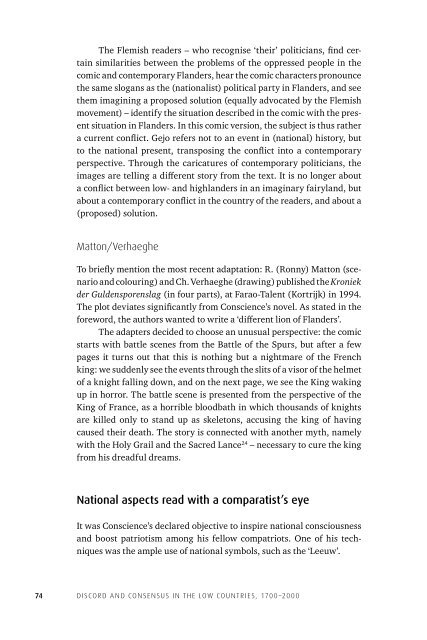Discord Consensus
7aze300jFJo
7aze300jFJo
You also want an ePaper? Increase the reach of your titles
YUMPU automatically turns print PDFs into web optimized ePapers that Google loves.
The Flemish readers –who recognise ‘their’ politicians, find certain<br />
similarities between the problems of the oppressed people in the<br />
comic and contemporary Flanders, hear the comic characters pronounce<br />
the same slogans as the (nationalist) political party in Flanders, and see<br />
them imagining a proposed solution (equally advocated by the Flemish<br />
movement) – identify the situation described in the comic with the present<br />
situation in Flanders. In this comic version, the subject is thus rather<br />
a current conflict. Gejo refers not to an event in (national) history, but<br />
to the national present, transposing the conflict into a contemporary<br />
perspective. Through the caricatures of contemporary politicians, the<br />
images are telling a different story from the text. It is no longer about<br />
a conflict between low-and highlanders in an imaginary fairyland, but<br />
about a contemporary conflict in the country of the readers, and about a<br />
(proposed) solution.<br />
Matton/Verhaeghe<br />
To briefly mention the most recent adaptation: R. (Ronny) Matton (scenario<br />
and colouring) and Ch. Verhaeghe (drawing) published the Kroniek<br />
der Guldensporenslag (in four parts), at Farao-Talent (Kortrijk) in 1994.<br />
The plot deviates significantly from Conscience’s novel. As stated in the<br />
foreword, the authors wanted to write a ‘different lion of Flanders’.<br />
The adapters decided to choose an unusual perspective: the comic<br />
starts with battle scenes from the Battle of the Spurs, but after a few<br />
pages it turns out that this is nothing but a nightmare of the French<br />
king: we suddenly see the events through the slits of a visor of the helmet<br />
of a knight falling down, and on the next page, we see the King waking<br />
up in horror. The battle scene is presented from the perspective of the<br />
King of France, as a horrible bloodbath in which thousands of knights<br />
are killed only to stand up as skeletons, accusing the king of having<br />
caused their death. The story is connected with another myth, namely<br />
with the Holy Grail and the Sacred Lance 24 –necessary to cure the king<br />
from his dreadful dreams.<br />
National aspects read with a comparatist’s eye<br />
It was Conscience’s declared objective to inspire national consciousness<br />
and boost patriotism among his fellow compatriots. One of his techniques<br />
was the ample use of national symbols, such as the ‘Leeuw’.<br />
74<br />
DISCORD AND CONSENSUS IN THE LOW COUNTRIES, 1700–2000


